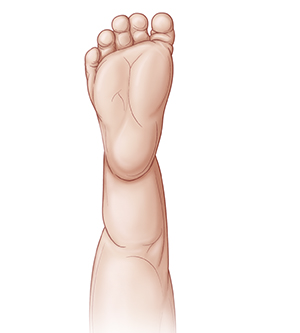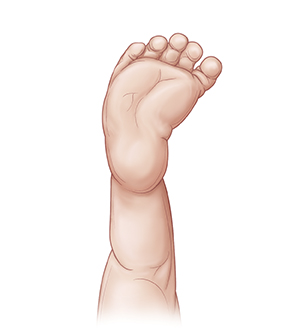When Your Child Has Metatarsus Adductus (MTA)
Your child was born with metatarsus adductus (MTA). This is a problem with the shape of the foot (deformity). The front part of the foot (called the forefoot) is hooked inward. The back part of the foot and ankle are normal. MTA is congenital, meaning your child was born with it. It may affect one or both feet. MTA is a common condition that causes no pain. It often goes away on its own.
 |
| Normal foot. |
 |
| Foot with MTA. |
What causes metatarsus adductus?
MTA tends to run in families. In many cases, the position of the foot in the uterus during pregnancy plays a role in the development of MTA.
How is metatarsus adductus diagnosed?
MTA is easily diagnosed by looking at the foot when the child is born. The healthcare provider will be able to tell MTA from other congenital deformities of the foot.
How is metatarsus adductus treated?
In most cases, MTA goes away on its own as the child grows. Parents may be given exercises to help the foot move into the correct position. Other treatments may be needed if the MTA is severe or doesn’t correct on its own, such as:
-
Stretching therapy. This is often prescribed to help move the forefoot into a normal position. The parent puts the child’s heel in the notch between their thumb and index finger. Then the parent holds the forefoot between the thumb and index finger of the other hand and gently pulls in the direction of the little toe.
-
Casting. This may be recommended if the foot doesn’t begin correcting on its own or if the MTA is stiff or hard to move into the correct position (rigid). The casts help move the foot into position. Casts are changed every few weeks. In some cases, special leg braces are also used.
-
Surgery. This is done only in rare cases.
Children should be evaluated regularly to see if their MTA is getting better or is resolved. Follow-up as advised by your child's healthcare provider.
What are the long-term concerns?
Many children with MTA get better with no treatment. And if your child needs treatment, it is often successful. In most cases, the child’s foot and leg will look normal and both feet will work fine. But if the MTA is severe and does not resolve, it can lead to bunions, hammertoes, and other foot problems.
Online Medical Reviewer:
Rahul Banerjee MD
Online Medical Reviewer:
Raymond Turley Jr PA-C
Online Medical Reviewer:
Rita Sather RN
Date Last Reviewed:
12/1/2021
© 2000-2024 The StayWell Company, LLC. All rights reserved. This information is not intended as a substitute for professional medical care. Always follow your healthcare professional's instructions.